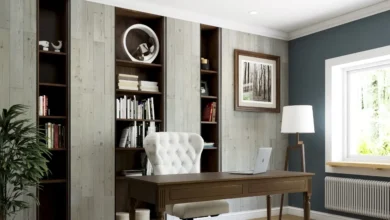How to easily divide a panel into specific dimensions

Learning How to divide a panel into specific dimensions is a skill that each DIY lover should master. Whether you update your home with acoustic lake panels of wooded walls or create a wall of characteristics with wooden and stick wood planks, precise measurements and clean cuts are essential for a seamless professional finish.
Many people are worried about making mistakes, waste materials or ending up with unequal panels when starting a DIY wall project. The good news is that with the right approach, the right tools and a clear method, dividing the panels in exact sizes you need becomes simple. In this guide, you will learn How to divide a panel into specific dimensions With confidence, allowing you to transform your space while ensuring that each panel aligns perfectly.
Understand the material panel
Before you start learning How to divide a panel into specific dimensionsIt is important to understand the documents you work with. Different panels require different cutting techniques and tools to obtain a clean and precise finish.
For example, Woody Walls offers Wall panels with acoustic slats Made of solid wood and oak veneer designed for easy DIY installation while providing superior sound absorption. These panels may require a fine tooth blade for smooth cuts without bursting the edges. The wooden plates Peel and Paste, another popular option of wooded walls, are light and are delivered with an adhesive support, which makes them easier to handle and cut in size with a pointed utility knife or a fine tooth saw.

If you work with plywood or MDF wall panelsYou will need to take additional care to avoid scabbling. The use of the painter ribbon along the cutting line can help protect the edges while guiding your saw gently. Understanding the thickness, finish and type of material of your panel will help you select the right tools and methods to divide your panels with precision and safe.
Taking the time to understand the type of panel you use will prevent you from frustration and material waste, ensuring that your DIY project turns out to be exactly as you have considered.
Essential tools for precision cutting
When learning How to divide a panel into specific dimensionsHaving the right tools guarantees that your cuts are precise and clean for a DIY project without frustration.
Here are the essential tools you will need:
- Tape measure: For precise measurements before marking your panels.
- Letteeded or Carpenter Square: Help mark perfectly straight and precise lines for your cuts.
- Pencil or fine marker: Makes clear and visible brands that you can easily follow during the cut.
- Circular saw with a fine tooth blade: Ideal for cutting the woody walls of acoustic slat panels and other wooden panels with a minimum of crushing.
- Jigsaw with a thin wooden blade: Useful for specific cuts around outings or corners.
- Utility knife with additional blades: Perfect for scoring and slamming the woody walls Peel and stick from the boards to exact sizes without damaging the finish.
- Cramps: Keep the panels safe in place to avoid moving during the cuts.
- Stable stable or Rorses de SAE: Support your panels while cutting, helping to maintain precision on longer panels.
The configuration of your workspace with these tools will help you to effectively divide your panels in specific dimensions, by ensuring that your DIY project of wooded walls seems clean and completed professionally.
How to divide a panel into specific dimensions: Step by step guide
Now that you have your ready tools, it’s time to learn How to divide a panel into specific dimensions With confidence for your DIY project. That you work with panels of acoustic slats of wooded walls or Pelage and stick boardsThese steps will help you make specific and clean cuts each time.
1. Measure twice
Start by measuring the space where your panel will be installed. Check your measurements to avoid errors and material waste. Note the exact dimensions you need for each panel.
2. Mark your cutting lines
Using a square of Ladreedge or Carpenter, mark clear straight lines on your panel according to your measurements. Use a fine pencil or marker so that your lines are easy to see during the cut.
3. Prepare your workspace
Configure your work or saw horses in a well -lit area. Use pliers to secure your panel in place, preventing any movement during cutting. This will help you maintain precision and security.
4. Choose the right cutting method
- For Acoustic latte panels in woody walls And other wooden panels, use a circular saw with a thin teeth blade for straight cuts.
- For detailed cuts or curves, use a jigsaw with a fine wooden blade.
- For Boarding and sticky boards of woody wallsUse a pointed utility knife to mark along your cutting line, then break the panel at the waist.

5. Cut slowly and regularly
Follow your marked line carefully, letting the saw or the knife do the work. Precipitation can lead to broken edges or unequal cuts.
6. Check your cut
After the cut, measure the panel again to ensure that it corresponds to the desired dimensions. If necessary, lightly sand the edges to smooth all roughness.
7. Clean and prepare the installation
Wipe your panels to remove any dust or debris, making sure they are clean and ready to be installed.
Current errors and how to avoid them
Learning How to divide a panel into specific dimensions Takes a practice, but avoiding current errors will save you time, money and frustration on your DIY project.
Measure
One of the most common problems is to measure once and cut immediately, only to find that the panel is too short or uneven. Always measure at least twice and mark your lines clearly to ensure precision.
Using bad tools
The use of a dull blade or the bad saw for your type of panel can cause exploded edges and rough cuts. For acoustic slats of woody walls, use a circular saw with a thin teeth blade, while a pointed utility knife is the best for coat and stick boards.
Support of the jump panel
Cutting panels without appropriate support can make them move or crack. Always use a stable tape or saw horses and fix your panels with pliers before cutting.
Rushing the Cut
The move too quickly can cause shredded edges and inaccurate dimensions. Let your saw or your knife move around regularly along the cutting line to maintain a clean edge.
Forget to check the adjustment
After the cut, always remind the panel to confirm that it corresponds to the required dimensions before installation. This simple step guarantees that your panels align perfectly when installed.
The main dishes and the next steps
Mastery How to divide a panel into specific dimensions Give your DIY projects a polite professional aspect while keeping time and equipment. With a meticulous measure, the right tools and a clear process, you can transform your space with confidence using acoustic slats of woody walls or peel and stick boards, ensuring that each panel adapts perfectly.
If you are ready to upgrade your space, explore the range of wood panels that are easy to install Woody walls designed for DIY lovers who appreciate design quality and flexibility. Acoustic panels that add heat and sound absorption to peel and stick boards that simplify your project, you will find a solution that aligns your style and skill level.
Visit Wooded walls To explore the best -selling panels, watch installation guides and order your samples today to discover the quality of the first hand. With free shipping of the United States within 48 hours, the transformation of your space has never been easier.








